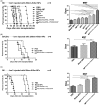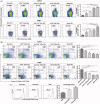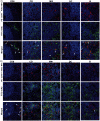On-target and direct modulation of alloreactive T cells by a nanoparticle carrying MHC alloantigen, regulatory molecules and CD47 in a murine model of alloskin transplantation
- PMID: 29508634
- PMCID: PMC6058602
- DOI: 10.1080/10717544.2018.1447049
On-target and direct modulation of alloreactive T cells by a nanoparticle carrying MHC alloantigen, regulatory molecules and CD47 in a murine model of alloskin transplantation
Abstract
Biomimetic nanoparticles have been reported as immune modulators in autoimmune diseases and allograft rejections by numerous researchers. However, most of the therapeutics carrying antigens, toxins or cytokines underlay the mechanism of antigen presentation by cellular uptake of NPs through pinocytosis and phagocytosis. Few researches focus on the direct and antigen-specific modulation on T cells by NPs and combined use of multiple regulatory molecules. Here, polylactic-co-glycolic acid nanoparticles (PLGA-NPs) were fabricated as scaffold to cocoupling H-2Kb-Ig dimer, anti-Fas mAb, PD-L1-Fc, TGF-β and CD47-Fc for the generation of alloantigen-presenting and tolerance-inducing NPs, termed killer NPs and followed by i.v. injection into a single MHC-mismatched murine model of alloskin transplantation. Three infusions prolonged alloskin graft survival for 45 days; depleted most of H-2Kb alloreactive CD8+ T cells in peripheral blood, spleen and local graft, in an antigen-specific manner. The killer NPs circulated throughout vasculature into various organs and local allograft, with a retention time up to 30 h. They made contacts with CD8+ T cells to facilitate vigorous apoptosis, inhibit the activation and proliferation of alloreactive CD8+ T cells and induce regulatory T cells in secondary lymphoid organs, with the greatly minimized uptake by phagocytes. More importantly, the impairment of host overall immune function and visible organ toxicity were not found. Our results provide the first experimental evidence for the direct and on-target modulation on alloreactive T cells by the biodegradable 200-nm killer NPs via co-presentation of alloantigen and multiple regulatory molecules, thus suggest a novel antigen-specific immune modulator for allograft rejections.
Keywords: Alloskin transplantation; alloreactive T cells; biomimetic nanoparticles; immunotherapy; major histocompatibility complex.
Figures






Similar articles
-
An Antigen-Presenting and Apoptosis-Inducing Polymer Microparticle Prolongs Alloskin Graft Survival by Selectively and Markedly Depleting Alloreactive CD8+ T Cells.Front Immunol. 2017 Jun 9;8:657. doi: 10.3389/fimmu.2017.00657. eCollection 2017. Front Immunol. 2017. PMID: 28649247 Free PMC article.
-
Direct modulation of myelin-autoreactive CD4+ and CD8+ T cells in EAE mice by a tolerogenic nanoparticle co-carrying myelin peptide-loaded major histocompatibility complexes, CD47 and multiple regulatory molecules.Int J Nanomedicine. 2018 Jun 27;13:3731-3750. doi: 10.2147/IJN.S164500. eCollection 2018. Int J Nanomedicine. 2018. PMID: 29983566 Free PMC article.
-
Antigen-specific killer polylactic-co-glycolic acid (PLGA) microspheres can prolong alloskin graft survival in a murine model.Immunol Invest. 2015;44(4):385-99. doi: 10.3109/08820139.2015.1014098. Immunol Invest. 2015. PMID: 25942349
-
Stealth functionalization of biomaterials and nanoparticles by CD47 mimicry.Int J Pharm. 2019 Oct 5;569:118628. doi: 10.1016/j.ijpharm.2019.118628. Epub 2019 Aug 14. Int J Pharm. 2019. PMID: 31421198 Review.
-
Pathways of major histocompatibility complex allorecognition.Curr Opin Organ Transplant. 2008 Aug;13(4):438-44. doi: 10.1097/MOT.0b013e328309ee31. Curr Opin Organ Transplant. 2008. PMID: 18685342 Free PMC article. Review.
Cited by
-
Use of Poly Lactic-co-glycolic Acid Nano and Micro Particles in the Delivery of Drugs Modulating Different Phases of Inflammation.Pharmaceutics. 2023 Jun 20;15(6):1772. doi: 10.3390/pharmaceutics15061772. Pharmaceutics. 2023. PMID: 37376219 Free PMC article. Review.
-
Implantable Immunosuppressant Delivery to Prevent Rejection in Transplantation.Int J Mol Sci. 2022 Jan 29;23(3):1592. doi: 10.3390/ijms23031592. Int J Mol Sci. 2022. PMID: 35163514 Free PMC article. Review.
-
Emerging approaches and technologies in transplantation: the potential game changers.Cell Mol Immunol. 2019 Apr;16(4):334-342. doi: 10.1038/s41423-019-0207-3. Epub 2019 Feb 13. Cell Mol Immunol. 2019. PMID: 30760918 Free PMC article. Review.
-
Nanoparticle-Based Interventions for Liver Transplantation.Int J Mol Sci. 2023 Apr 19;24(8):7496. doi: 10.3390/ijms24087496. Int J Mol Sci. 2023. PMID: 37108659 Free PMC article. Review.
-
Polymeric micro- and nanoparticles for immune modulation.Biomater Sci. 2018 Dec 18;7(1):14-30. doi: 10.1039/c8bm01285g. Biomater Sci. 2018. PMID: 30418444 Free PMC article. Review.
References
-
- Brandhorst G, Weigand S, Eberle C, et al. (2013). CD4+ immune response as a potential biomarker of patient reported inflammatory bowel disease (IBD) activity. Clin Chim Acta 421:31–3. - PubMed
MeSH terms
Substances
LinkOut - more resources
Full Text Sources
Other Literature Sources
Research Materials
Miscellaneous
